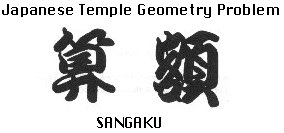 |


Since 1996
 |


During the Edo period (1603-1867) Japan was cut off from the western world. But learned poeple of all classes ,from farmers to samurai, produced theorems in Euclidean geometry. These theorems appeared as beautifully colored drawings on wooden tablets which were hung under one of the roof in the precincts of a shrine or temple.
The tablet was called a SANGAKU which means a mathematics tablet in Japanese. Many skilled geometers dedicated a SANGAKU in order to thank the god for the discovery of a theorem. The proof of the proposed theorem was rarely given. This was interpreted as a challenge to other geometers, "See if you can prove this."
In two hundred years, some shrines and temples have been abandoned or destroyed, and the SANGAKU they had no longer exist. But about 820 SANGAKUs have survived , and some of them can be seen in the HOME PAGE.
I would like to send some image files of SANGAKUs by the Internet because SANGAKU is one of the customs left only in Japan.
References :
H. Fukagawa & D. Pedoe "Japanese Temple Geometry Problems Sangaku" Winnipeg, Canada, 1989
T. Rothman "Japanese Temple Geometry" SCIENTIFIC AMERICAN May 1998
 kotera@asahi.email.ne.jp
kotera@asahi.email.ne.jp
 |
|What's SANGI?|
| Contents of Jour. of History of Math,Japan|
History of Mathematics Archive|
|Japanese Temple Mathematical problems in Nagano Pref. Japan|
|Sanpo Koren |
|
 Return to Home Page(Japanese)
Return to Home Page(Japanese)
 MathMuseum(JAPAN)
MathMuseum(JAPAN)
 Links2Go Web Surfing |